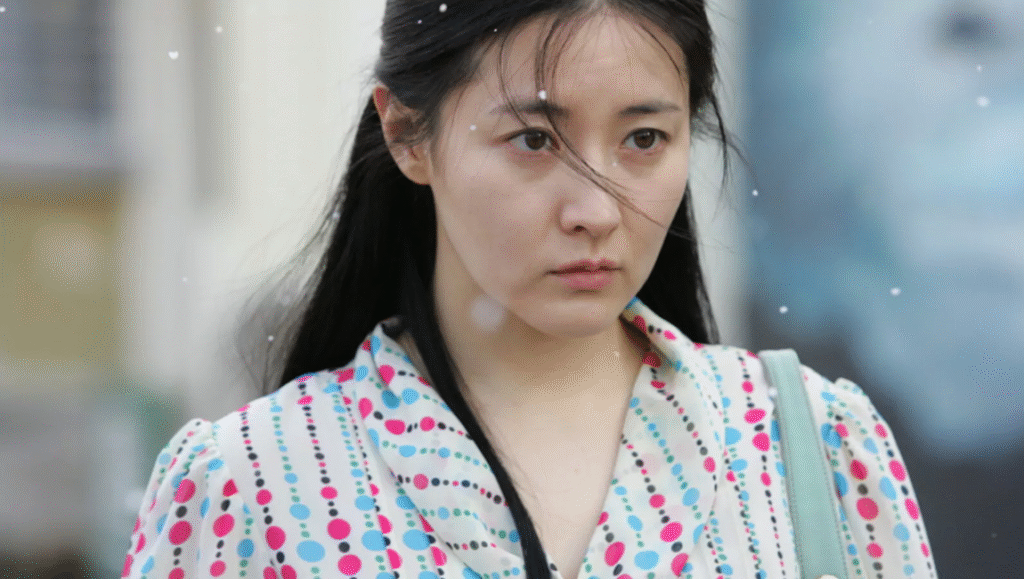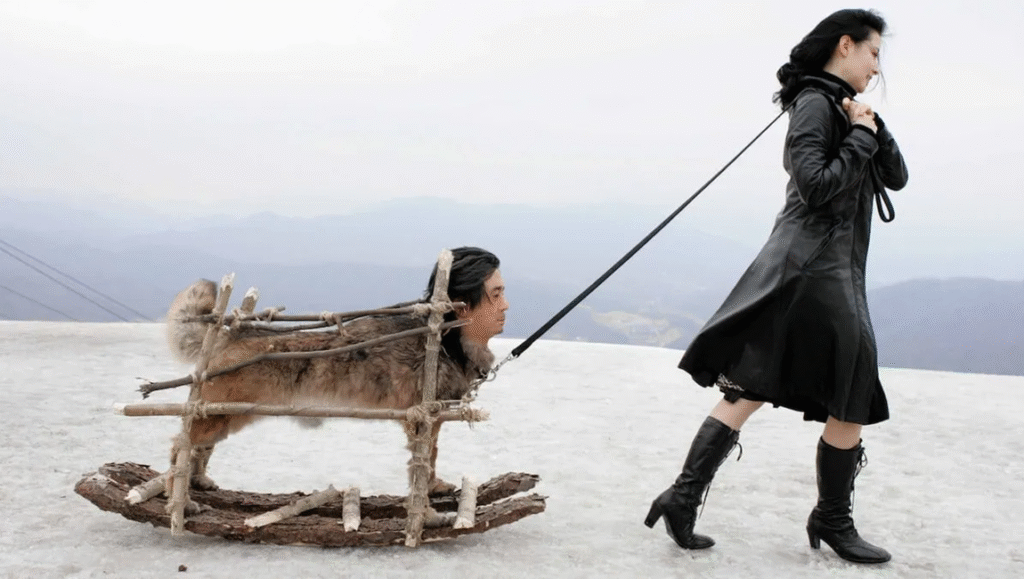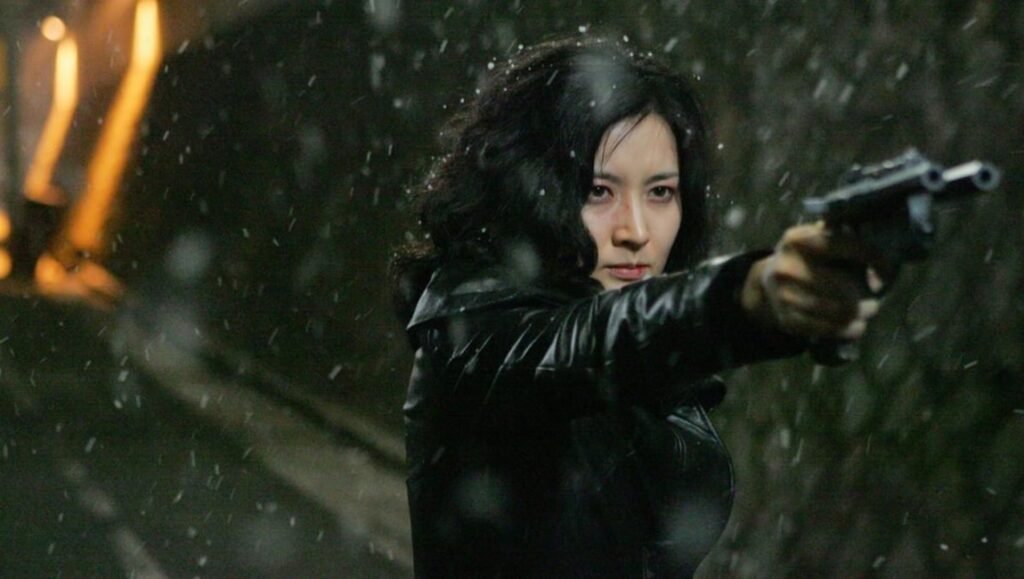After Oldboy (2003) won the Grand Prix at a Cannes Film Festival presided over by a Quentin Tarantino-led jury in 2004, an overwhelming amount of anticipation was built around Park Chan-wook’s follow-up project. The news that he would once again return to a revenge tale and the casting announcement of Lee Young-ae — then the biggest star in Korea, who had previously worked with the director in Joint Security Area (2000) — further inflated the hype. While Lady Vengeance (2005), the final entry in the so-called “Vengeance Trilogy,” ended up being the most commercially successful of the trilogy at the domestic box office, it garnered neither competition awards at Venice where it premiered, nor the ecstatic critical praise showered on Sympathy for Mr. Vengeance (2002) or Oldboy. Those who were eagerly waiting for the same level of bloodbath and emotional extremities demonstrated in its sibling films walked out of the theater wanting more; Park’s skeptics, meanwhile, acknowledged its more subdued handling of violence and focus on ethical dilemmas as a sign of the director’s maturation, but still wrote it off as juvenile. Perhaps Lady Vengeance was a film destined for disappointment.
Unlike its predecessors, Lady Vengeance proceeds in a rather complicated narrative structure. The film opens with the charismatic heroine Lee Geum-ja being released from prison after serving thirteen and a half years for allegedly kidnapping and murdering a six-year-old boy. The series of flashbacks that follow introduces her former cellmates, who later reemerge to assist Geum-ja in finding and killing Baek Han-sang, a cartoonishly evil English teacher actually responsible for the murder. She starts working at a bakery named Naruse, where she runs into the detective who apprehended her years ago despite knowing her innocence. Another flashback sequence reveals the circumstances of her decision to take the blame: Baek threatened Geum-ja with the life of her child, whom he later put up for international adoption. She soon travels to Australia to reunite with her daughter, Jenny. Upon returning to Seoul, Geum-ja abducts her nemesis and transports him to an abandoned school in a remote area. Just as she is about to execute her revenge, however, she is shocked to discover that Baek has since killed more kids. Subsumed by the guilt that these murders could have been prevented, she revises her plan and reaches out to the parents of the murdered children.
The film begins again, so to speak, once the victims’ families gather at the site of retribution. Unlike the film’s first half, adorned with Park’s distinctly stylish transitions and dry humor, the second half plays like a chamber drama with suffocating somberness. The families painfully sit through Baek’s snuff videos, and afterwards decide to collectively punish him. Although Park exercises a great deal of technical restraint in this portion, a generous amount of graphic violence ensues as they take turns torturing Baek using knives of various sizes, an axe, and a pair of scissors that once belonged to one of the slain kids. The moment of catharsis passes by quickly, and the material concerns soon kick in. The executioners discuss the details concerning retrieving extortion money and part ways as if nothing has happened. Geum-ja, left with neither the satisfaction of vengeance nor a future to look forward to, buries her face in a tofu-shaped cake in the middle of a street, weathering the snow that piles on the ground.
Twenty years on, Geum-ja remains a pop cultural icon in Korea. In a 2017 poll conducted by major Korean film magazine Cine21, Geum-ja topped the list of the most memorable woman characters in the history of national cinema. Everything from her bold red eyeshadow, deadpan delivery of the line “none of your business,” Rick Owens-like leather trench, rectangular Alain Mikli sunglasses, and name itself has been infinitely memefied and parodied. She is something like an angel of vengeance who has no qualms about manipulating others and insists on every aspect of her revenge scheme being beautiful, even at the risk of impracticality. At the same time, her maternal guilt over a child she was forced to abandon and her willingness to set aside her private grudge in order to make space for those wronged by the man she plots to kill make her unmistakably a human being with a heart. Geum-ja’s elusiveness is precisely what makes her an enduring character in the popular imagination.

But the most fascinating critical reassessment comes from film scholar Han Sang-eon’s 2013 essay “Sympathy for Lady Vengeance and Historical Allegory,” which excavates the political underlayer that results in a completely different interpretation of its central plot. Han begins by deciphering the corresponding Chinese characters for the name Geum-ja (금자): 金子. In Japanese, the characters read as Kaneko, like Japanese anarchist Kaneko Fumiko, who was imprisoned for plotting to assassinate the members of the Japanese Imperial Army in 1926. In English, they can be read as Goldman, as in revolutionary anarchist Emma Goldman. This simple decipherment unveils the ideological underpinning of the retribution depicted in the film and renders Geum-ja a symbolic executioner bearing the names of foundational anarcho-feminists of the 20th century.
In fact, much of Lady Vengeance is suffused with characters and meta-elements that invoke the tumultuous political history of the Korean peninsula. Han also points out that Park Yi-jeong, the name of Geum-ja’s most loyal accomplice, is a pseudonym adopted by Park Hun-young, a deputy leader of the Workers’ Party of South Korea who waged a guerrilla struggle against the U.S. military and its Korean fascist lackeys. Ko Seon-sook, an elderly North Korean inmate incarcerated for her espionage activities in the South, bears more than passing resemblances to Lee Sun-sil, a real-life North Korean agent who was born in 1916 and operated in Seoul throughout the ’80s. Kim Se-won, one of South Korea’s most popular voice actors who narrates the film as Jenny at an older age, is the daughter of renowned Korean composer Kim Sun-nam, who defected to the North when she was just three. Like Jenny, Kim Se-won never knew her dad.
The political subtext of the two women, whose names represent anarchism and communism, aided by the characters whose lives were invariably shaped by the Cold War, murdering an evil English teacher is almost too on the nose. But Park refuses to reduce Baek Han-sang into a caricature personification of the evils of the American Empire. In a pivotal scene where the parents of murdered children congregate at an abandoned school, the film briefly cuts to an insert of the old Mitsubishi camcorder used to document his atrocities. During Korea’s colonial years, Mitsubishi managed the coal mine located on Hashima Island, where hundreds of Korean civilians were conscripted to perform forced labor under unspeakably harsh conditions. After the fall of the Japanese Empire, the Korean peninsula was divided along the 38th parallel: the Soviet military occupying the North and the U.S. military the South. The Americans enlisted the help of chinilpa — ethnic Koreans who collaborated with Imperial Japan — to curb the spread of communism in the South. During the Korean War, Japan’s heavy industries, including Mitsubishi, profited handsomely from repairing the damaged American military vehicles. The inclusion of the Mitsubishi camera suggests that it is this unending history of imperialism itself, rather than a specific imperial power, that Baek embodies.

By the time Park made Lady Vengeance, South Korea was a young liberal democracy that had recovered from the Asian Financial Crisis of 1997 much quicker than anticipated. The economy was growing again, and newfound optimism permeated the air under the two consecutive center-left presidencies between 1998 and 2007. The country’s political mood at this time was decidedly future-oriented, eschewing historical reckoning in favor of looking ahead at a future filled with the prosperity that rapid neoliberal consolidation seemed to promise. But many artists on the left went against the grain and chose to confront the 20th century. Bong Joon-ho made Memories of Murder (2003), a devastating procedural thriller in dialogue with the history of South Korean military juntas, and Park made Lady Vengeance. Park’s film, especially in its second half where the collective punishment of Baek slowly unfolds, feels like a memorial service for those who suffered under imperial violence. He has used the anamorphic format to great artistic effect in several of his films, densely populating the wide frame with stunning set designs and intricate blocking. But here, the use of CinemaScope seems to channel Fritz Lang’s observation about the aspect ratio from Jean-Luc Godard’s Contempt (1963): “It wasn’t made for people but for snakes and funerals.” Given the director’s striking use of color, the existence of a “Fade to Black and White” version, in which the images gradually turn monochrome in the final 35 minutes, further indicates his intention to evoke a sense of grief.
Unlike Memories of Murder, though, the political layers embedded in Lady Vengeance are curiously elusive. The fact that the film’s historical allegory went woefully unnoticed invites the question about the efficacy of its extreme subtlety. Just three years earlier, with Sympathy for Mr. Vengeance, Park had learned the hard way that the market had no tolerance for a ferocious tale of class inequalities that culminates in ghastly violence; it only made back half of its budget during a three-week theatrical run. Thankfully, the financial disaster was offset the following year with the success of Oldboy, which is equally gory and additionally laden with incestuous desires, but the implication was clear: violence and sex sell as long as they are divorced from a critique of neoliberalism. Lady Vengeance was, then, his attempt to marry the political indignation of Mr. Vengeance with the more abstract aesthetic choices made in Oldboy. In the end, his strategy paid off at the box office.
But it would be unfair to characterize the film’s political obscurity as a cowardly, calculated decision to placate the market. The same year that Lady Vengeance came out, Im Sang-soo’s The President’s Last Bang (2005), a jet-black comedy that satirizes the assassination of fascist president Park Chung-hee, faced a legal challenge instigated by Park’s children Park Ji-man and Park Geun-hye, the latter of whom would become president herself in 2014. Citing its irreverent depiction of South Korea’s longest-reigning dictator, Park’s children requested an immediate injunction against the film. The court denied their injunction request but ruled that the archival footage of the Busan-Masan Uprising and Park’s state funeral, which respectively open and conclude it, be removed on the grounds that they may give viewers the false impression that the film is a docudrama, not a work of fiction. Contrary to the naive political optimism in the air at the time, artistic expressions grounded in the critical engagement with the national history remained forbidden by law. In hindsight, the covertness of political commentary in Lady Vengeance feels incredibly attuned to the zeitgeist of South Korea in the aughts.
Ultimately, the perceived obscurity of the allegory in Lady Vengeance has more to do with gaps in the viewer’s grasp of Korea’s modern political history than Park’s shortcomings as a leftist filmmaker. In this wild historical fantasy, Park summons Geum-ja not just to put an end to the cycle of barbarism in the name of imperialism, but also to urge us to fight against historical amnesia. Then, what does it mean that even after killing Baek, she does not find the redemption she has desperately sought in the end? Eliminating the oppressor — in this case, the literal and ideological descendants of chinilpa that still hold so much power and the American military bases in Korea — is the first step in the long march toward decolonization and socialism. The redemptive future has yet to be built, and the actual hard work lies in what Geum-ja does after the revenge. That she has apparently failed is no cause for despair. If not Geum-ja, Jenny, her children, or her grandchildren would continue the struggle. This is the most politically clear-eyed and mature Park has ever been in his career, and Lady Vengeance is one of the most provocative and empowering political films in the history of Korean cinema.


Comments are closed.